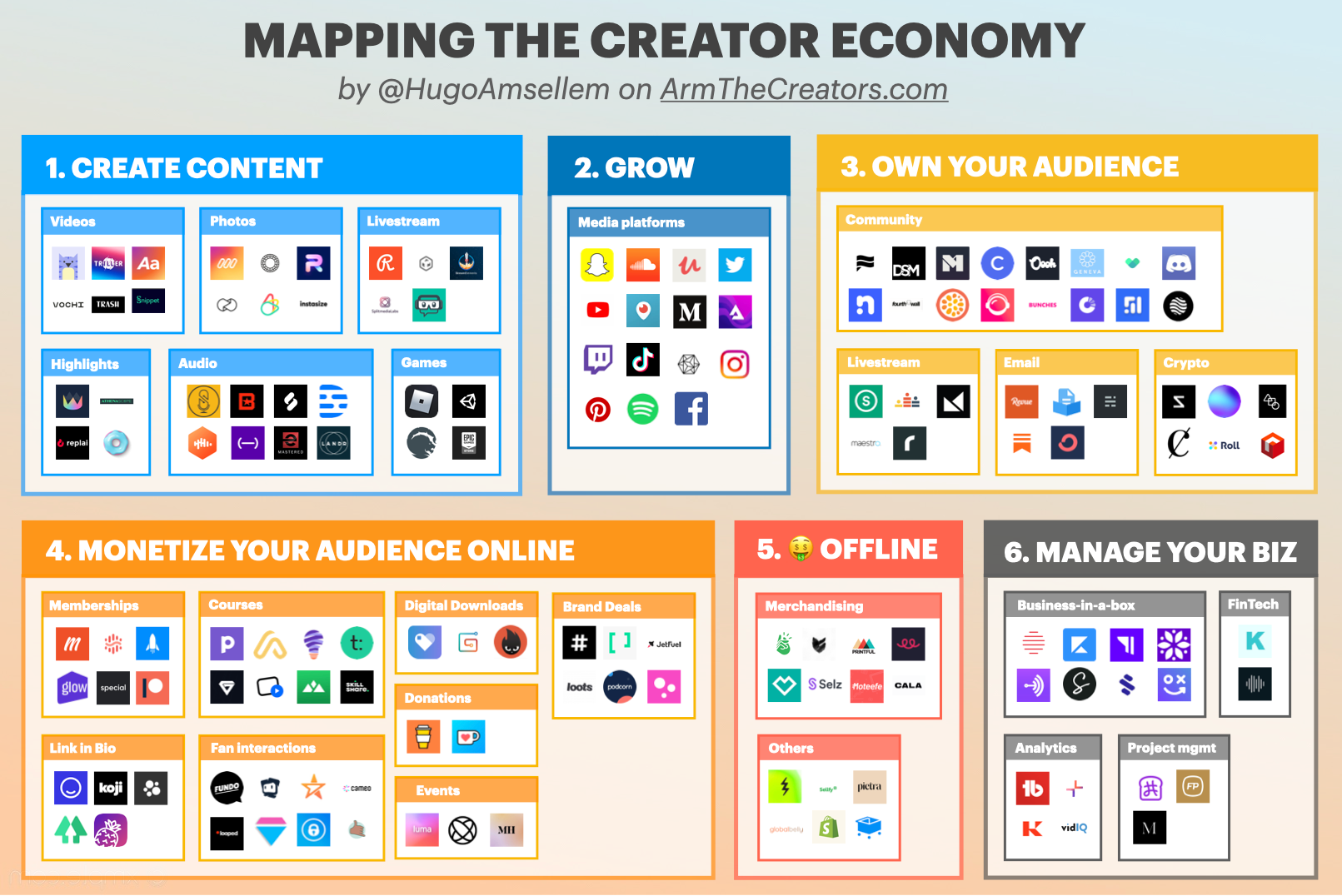The Rise Of The Creator Economy

I write about the future of Business, Psychology, and the Creator Economy. My goal is to educate, motivate, and create educational content for my readers. If this interests you, Subscribe to my newsletter and get new articles directly to your inbox!
Okay, What Even Is The Creator Economy?
At its core, the Creator Economy describes someone earning income from making and distributing online content. Historically, this industry is often made up of individuals sharing a unique skill, ability, or perspective that they can disseminate, and ideally monetize, to their audience using online platforms. This could be Instagram Influencers, Twitch Streamers, Artists, Writers, E-Courses, Virtual Yoga Instructors, etc… Forget the 9-5 minimum wage job; many creators that own a unique niche or have a large audience can make significant revenue through one of five main categories: Advertisements, One-Off Sales and/or donations, Subscriptions, Brand Sponsorships, and Influencer Marketing, and Affiliate Marketing. Let’s dive in, shall we?
Before We Continue, Let’s Explain All Five Main Monetization Methods
Advertisements: Creators with a certain number of followers can monetize their content through ads. Example: You create a podcast that has 300 weekly listeners, and give one minute to an advertiser in the middle of your episode.
One-Off Sales & Donations: Consumers make one-off payments to creators. Example: You sell a course about your knowledge of Search Engine Optimization (SEO) for $50 on Gumroad.
Subscriptions: Fans pay a set, recurring amount to creators, generally in exchange for exclusive or first-access content. Example: You sell daily insight about your successful stock market portfolio on Substack for $500 per year for unlimited access.
Brand Sponsorships & Influencer Marketing: Influencers partner directly with brands and are paid to post products on their behalf. Influencers are typically paid upfront (vs affiliate marketing, where $ are based on commission). Example: An Instagram model with 30,000 followers will get $10,000 from [Insert Brand Here] to post a picture with their [Insert Product Here].
Affiliate Marketing: Brands provide creators with an affiliate link for products. When a product sells, creators earn a commission for the sale. For example, you share a link to an Amazon product on your blog post. If someone buys that product, you get a % of the $.
Now Let’s Talk About The Future Of The Creator Economy
I’ve spent a lot of time thinking about this question. There’s a huge opportunity for businesses and individuals to take advantage of hyper-niche categories (Examples: Bachelorette Fangirls, Call Of Duty Twitch Streamers, Game of Throne Superfans, etc.) with a potentially large and rapidly growing online audience. If you create a skill, ability, or perspective that adds value to a niche, you will grow your audience, monetize it, and become a successful member of the Creator Economy. I mean come on, this is exciting stuff!!
As the “barrier of entry” for the Creator Economy dwindles, people who aren’t as tech-savvy or tech natives are able to be included. Etsy, for example, is easy to set up and can immediately pay off with your niche audience by providing a rich audience and many user-friendly features. Say you’re an artist looking to sell your paintings. What used to be next-to-impossible to sell your paintings online is now easier than it has ever been with tools and platforms making that experience simple. Don’t get me wrong, there is still a steep learning curve; however, it’s easier than ever to find your niche audience and spread your creativity into the world. I know what you’re thinking. That the market is going to get saturated. Well, you’re absolutely right, and it will be interesting to see how Creatives and companies pivot to stand out. It will be interesting to watch in the next few years. Regardless, the low barrier of entry will continue to help the Creator Economy in the near term and, in doing so, will separate the big winners and big losers in this space. I predict multi-billion dollar companies who consolidate other platforms and become the main go-to for creatives.
Below I added a couple of images highlighting some of the vertical-specific work platforms associated with the vague “Creator Economy” landscape:
Some Random Fun Facts About The Creator Economy
This industry is still in its infancy and will exponentially grow in the next few years. Check out a few of these stats that I found on Influencer Marketing Hub Post (Published March 26, 2021):
50 Million Join the Creator Economy
46.7 Million Creators Consider Themselves Amateurs
2 Million Global Creators Make Six Figures
Sponsored Influencers Are Worth $8 Billion Today
29% of American Kids Want to be a YouTube Star
22 Thousand YouTube Creators Have More Than 1 Million Subscribers
500,000 Instagrammers Have More Than 100,000 Followers
300,000 + Twitch Streamers Are Either Partners or Affiliates
Nearly 17 Million Americans Earned Income Posting Their Personal Creations on Nine Platforms in 2017
World Record for Hours Streamed in a Month is 595 Hours
52% of Creators Spent 0-39 Hours Per Month Devoted to Social Content
$21 Million Estimated Monthly Payouts on Patreon
In the end, my goal is to understand the Creator Economy at a deeper level in the next few years. Plus, I want to continue creating of course! I’ve already created my freelancing business, Rose City Marketing, and will continue to use my skills to try and grow my online audience and publish amazing content for y’all. Hope you enjoyed :)
Hayden Schuster






